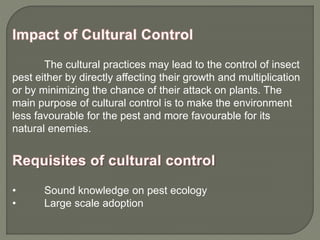The 7-Minute Rule for Pestwise
The 7-Minute Rule for Pestwise
Blog Article
Not known Details About Pestwise
Table of ContentsPestwise Can Be Fun For Everyone7 Simple Techniques For PestwiseThe Pestwise DiariesPestwise - Questions10 Easy Facts About Pestwise ExplainedAn Unbiased View of PestwiseOur Pestwise Diaries

Q. Specify "integrated bug administration" (IPM) and list numerous possible control methods that may be used in an IPM approach. A. Integrated insect management is the integrating of proper insect control methods into a solitary plan to decrease insects and their damages to an acceptable degree. Pest control techniques may consist of: host resistance, biological control, cultural control, mechanical control, hygiene, and chemical (chemical) control.
The Main Principles Of Pestwise
What can you do to keep the insects you are attempting to manage from becoming resistant to the pesticides you make use of? A. Parasite resistance can be lowered by utilizing incorporated insect management and turning the sorts of chemicals used.
Insects are a crucial risk to the farming organization, and incorporated pest management helps growers address and alleviate these risks. Integrated bug monitoring makes use of a number of approaches in complex, thus being a more effective service to the issue. Exterminator. In certain, removing hostile chemical methods permits reducing harm to people and the setting by making use of all-natural and more secure choices instead
The Best Guide To Pestwise
The objective of incorporated insect management is to minimize this injury and control acceptable infestation degrees instead of eradicate all undesirable populaces. This is why it is very important to understand what measures are justified in each instance and use hostile ones only when various other integrated monitoring methods don't work. Integrated management mitigates the adverse consequences of a non-IPM strategy, and the primary advantages of IPM Advantages of IPM.
An appropriate understanding of the problem scope determines if the issue needs to be addressed. are the following components of an IPM program since it is necessary to understand if the organisms make prospective threats and pick the incorporated management choices or the specific pesticide usage. plan to minimize problems by applying different agronomic methods.
Pestwise - Questions
if prevention was inadequate. Integrated monitoring alternatives in an IPM program start with more secure to much more hostile ones. For instance, target or program chemical splashing might follow hands-on removal or trapping that hasn't helped. Those integrated administration elements help understand how to plan and execute an IPM program step by step: Monitor your crops consistently.

Amongst others, IPM social techniques consist of the following field administration strategies: soil treatment; option of suitable plants; crop turning; interplanting or strip cropping; option of growing days; weed control; use of trap plants. Favorable soil problems speed up plant development, and vigorous crops are a lot more resistant to invasions. Healthy plants and seeds predetermine successful crop growth, so it is important to select pest-free growing product with solid origins.
Therefore, to name a few applications, plant rotation can be successfully made use of as an integrated bug management method. Pests spread slower if rows of different crop kinds divide their host plants in intercropping or strip cropping, which is also used in the integrated insect administration system. Conversely, invasions boost when plants of the exact same plant kind or family members expand with each other.
, as well as tomatoes. Planting catch plants in spots is an additional choice for IPM intercropping. This incorporated bug administration method recommends drawing in insects to specific plants and after that regulating them with chemical or mechanical methods.
How Pestwise can Save You Time, Stress, and Money.
Barriers are normal examples of physical IPM approaches. Fully grown bugs or their eggs and larvae are gathered by hand and damaged.

Department of Plant Sciences. This incorporated monitoring method suggests a typical method of damaging parasites by killers, parasitoids, pathogens, and various other organic control representatives (also known as hostile microorganisms). The duty of organic control in IPM is to.
The Pestwise Statements
With time, their population ended up being a real nuisance to farmers alongside aboriginal kangaroos or dingoes. The walking cane toad is one more case illustrating incorporated organic control failure hereof when it rejected to search the target varieties and came to be a bug itself. Parasitoids develop on or within their hosts to eventually eliminate them after developing.
Report this page